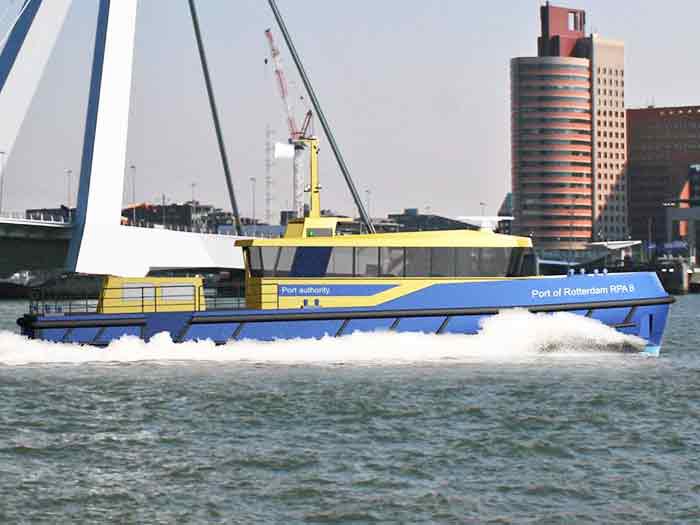
Hull Vane saves energy, reduces wake
Written by Nick Blenkey
Rendering of the new RPA-8 patrol vessel
DECEMBER 14, 2016 — A new 25 m RPA-8 patrol vessel for the Port of Rotterdam under construction at Shipyard Kooiman, Zwijndrecht, Netherlands will sail in a densely populated area, with heavy traffic on the waterways.
Its design is the result of a competitive public tender process that stressed the importance of the vessel’s complete life-cycle costs and the need for minimal emissions and minimal wave formation.
Shipyard Kooiman contracted Van Oossanen Naval Architecture for the winning hull design. Working predominantly in the yacht sector, Van Oossanen has built a solid reputation for efficient hulls sailing at high speed-to-length ratios.
The design which best suited the operational profile – a seldom-required top speed of 30 km/h, and a normal cruising speed of 20 km/h – is a combination of two patented innovations launched by Van Oossanen: the Fast Displacement Hull Form (FDHF) and the Hull Vane.
The concept of the FDHF is both simple and innovative. The vessel is designed to stay in displacement mode at high speeds with almost no running trim, and the complete absence of a “hump speed”.
 A significant amount of hydrodynamic lift is generated by the Hull Vane, a hydrofoil-like appendage fixed to the transom. This lift is angled forward, and therefore has a horizontal component pushing the vessel forward.
A significant amount of hydrodynamic lift is generated by the Hull Vane, a hydrofoil-like appendage fixed to the transom. This lift is angled forward, and therefore has a horizontal component pushing the vessel forward.
Hull Vane
Self-propelled model tests at MARIN (Maritime Research Institute Netherlands) with and without Hull Vane showed that the energy saving device reduces the required propulsion power – and therefore the fuel consumption – by 25% at 20 km/h , by 29% at 27 km/h and by 22% at 35 km/h.
The Hull Vane also has a marked influence on the wave profile of the vessel. MARIN measured both the wave pattern immediately behind the transom and the waves at a distance. The tender specification included a firm requirement for low wave generation: at 20 km/h, the generated wave at 30 meters from the boat should not exceed 40 cm, which is significantly below the wave generated by the current fleet of patrol vessels at this speed. The model tests showed this height to be only 7 cm for the boat with Hull Vaneand 10 cm for the boat without Hull Vane.
According to Van Oossanen, this shows that the Hull Vane is not a “fix for a bad design”, but rather an improvement for a good design, similar to how a bulbous bow is an integral part of a large ferry design.
Reducing the resistance means consuming less fuel, and therefore emitting correspondingly less greenhouse gas CO2, and carcinogens such as NOx and particulate matter into the atmosphere. With 350 sailing days per year, the Hull Vane on RPA-8 reduces the emissions of CO2 by 162 tons, or the equivalent of over 8.000 trees growing for a year.
In addition, Shipyard Kooiman was able to install a smaller propulsion plant (736 kW instead of 939 kW), which offers a lot of secondary benefits, such as cost saving, reduced ventilation requirements, reduced exhaust systems, a lower noise level and more space in the engine room. Due to the cost savings, there was no net cost for the Hull Vane.
For efficient patrolling at low speeds and a reduction in engine running hours of 40%, RPA-8 will have a parallel-hybrid propulsion installation from Holland Ship Electric.
This system allows the boat to be sailed in diesel-electric mode up to 25 km/h on one of the main engines, or with both main engines engaged in diesel-direct mode from 25 km/h to 35 km/h. The engines are always properly loaded, which means more efficient combustion and less smoke generation.
Shipyard Kooiman expects the design to become a new benchmark for inland waterway and near-shore patrol and survey vessels.
The public tender process proved to be an ideal way to adopt proven innovations and achieve an optimal integrated solution. The key was to not look exclusively at build cost and top speed, but to look at the complete life cycle costs based on a realistic operational profile.
Difference in stern wave at 20 km/h, with Hull Vane(left) vs. without Hull Vane (right)

Wave pattern at 26 km/h without (top) and with (bottom) Hull Vane






Leave a Reply
You must be logged in to post a comment.